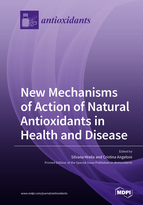New Mechanisms of Action of Natural Antioxidants in Health and Disease
A special issue of Antioxidants (ISSN 2076-3921). This special issue belongs to the section "Health Outcomes of Antioxidants and Oxidative Stress".
Deadline for manuscript submissions: closed (31 December 2019) | Viewed by 56769
Special Issue Editors
Interests: cellular biochemistry; nutritional biochemistry; oxidative stress; antioxidants; nutraceuticals
Special Issues, Collections and Topics in MDPI journals
Interests: nutritional biochemistry; neurodegenerative diseases; oxidative stress; inflammation; nutraceuticals; ageing
Special Issues, Collections and Topics in MDPI journals
Special Issue Information
Dear Colleagues,
The current understanding of the complex role of ROS in the organism and pathological sequelae of oxidative stress points to the necessity of comprehensive studies of antioxidant reactivities and interactions with cellular constituents. Many of the protective actions of natural antioxidants in health and diseases have been ascribed to their antioxidant properties, but in the last years, many studies have suggested that their classical hydrogen-donating antioxidant activity is unlikely to be the sole explanation for their effects. First of all, natural antioxidants are broadly metabolized in vivo, resulting in significant modifications. Moreover, the concentrations of natural antioxidants and their metabolites in vivo are lower than that usually utilized in vitro. Consequently, natural antioxidants do not exert their biological action in vivo via simply reacting with ROS. Accumulating evidence suggests that the cellular effects of natural antioxidants may be mediated by their interactions with specific proteins central to intracellular signaling cascades, modulating the expression and activity of key proteins, influencing epigenetic mechanisms or modulating gut microbiota.
We invite you to submit your research findings to this Special Issue, which has the aim to present the current state-of-the-art on new mechanisms of action of natural antioxidants in both health and disease. The research can include both in vitro and in vivo studies related to the following topics: antioxidant metabolism and bioavailability, signal transduction modulation, genomic and proteomic studies of purified molecules or antioxidant rich extracts, epigenetic regulation, cell cycle, cytoprotection, and cytotoxicity. Original research articles, review articles, clinical trials, and meta-analyzing studies are welcome.
Prof. Dr. Silvana Hrelia
Prof. Dr. Cristina Angeloni
Guest Editors
Manuscript Submission Information
Manuscripts should be submitted online at www.mdpi.com by registering and logging in to this website. Once you are registered, click here to go to the submission form. Manuscripts can be submitted until the deadline. All submissions that pass pre-check are peer-reviewed. Accepted papers will be published continuously in the journal (as soon as accepted) and will be listed together on the special issue website. Research articles, review articles as well as short communications are invited. For planned papers, a title and short abstract (about 100 words) can be sent to the Editorial Office for announcement on this website.
Submitted manuscripts should not have been published previously, nor be under consideration for publication elsewhere (except conference proceedings papers). All manuscripts are thoroughly refereed through a single-blind peer-review process. A guide for authors and other relevant information for submission of manuscripts is available on the Instructions for Authors page. Antioxidants is an international peer-reviewed open access monthly journal published by MDPI.
Please visit the Instructions for Authors page before submitting a manuscript. The Article Processing Charge (APC) for publication in this open access journal is 2900 CHF (Swiss Francs). Submitted papers should be well formatted and use good English. Authors may use MDPI's English editing service prior to publication or during author revisions.
Keywords
- Natural antioxidants
- Oxidative stress
- Cell biochemistry
- Signal transduction
- Metabolism
- Disease








